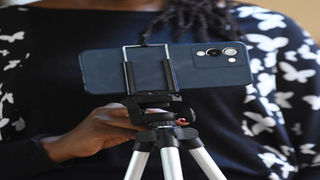
A woman captures a video using a smartphone on a tripod. Today, smartphone cameras have better lenses, higher resolution with the ability to zoom in to identify something. PHOTO/MICHAEL KAKUMIRIZI
|Technology
Prime
Phone cameras offer so much more than selfies
What you need to know:
Smartphone cameras are slowly replacing rival DSLR cameras thanks to their versatility.
Did you ever think that that camera on your smartphone would do more than taking selfies?
It is no surprise that today, brands and big businesses are being built and made by simply owning a good smartphone with a good camera. While at that, smartphone cameras are slowly replacing the rival DSLR cameras thanks to their versatile functionality.
Phone cameras offer so much more than selfies
Smartphone cameras are slowly replacing rival DSLR cameras thanks to their versatility.
Content creators such as bloggers and vlogger, for instance, increasingly prefer using their smartphones as the primary cameras given their convenience, portability, and affordability.
In the past years, obtaining that kind of work required professional equipment such as big cameras, lighting reflectors, booked venues, and so much more; costs an arm and a leg.
Then, there is the part of waiting for the captured data to be processed and edited by sophisticated computer programmes before getting the final product.
In light of that, Mr Ivan Sewajje, the brand manager at Innovation Village and MoTIV says, manufacturers have put a lot of effort in improving the phone camera hence making it one of the biggest selling points of smartphones. This being both hard ware and software.
The hardware enhancement includes parameters such as the sensor size, the aperture of the lens and some phones having more than one camera to improve their photographic capabilities.
Additionally, the incorporation of Artificial Intelligence (AI) algorithms to the software component of the phone cameras is fast enhancing many facets of image processing in phone cameras.
Software boosters
Mr Moses Dipak, a photographer and videographer at Innovation Village says, “Feature phones, especially low and mid-range phone manufacturers invest highly in software enhancers. These are embedded in the mobile operating system (OS) to somehow make up for the market cap at the lower income earners’ end. Despite the camera remaining of relatively lower quality, the software dynamics enhance its output instantly to get a good picture.”
These handsets costing about Shs1.8m are nigh-on inseparable from smartphones that cost twice as much, covering almost all needs without leaving one’s wallet dry.
These include and are not limited to UK made Nothing Phone 1 with a distinctive styling and clever lighting, most Infinix and Tecno phones, especially those in the African market.
Conversely, on the high-end, some phone companies such as Google Pixels have taken AI to another level.
“With lens, you can search what you see with your camera, take a picture, a screenshot, or long press an image you see while browsing, and get a range of visual results to explore.”
With these camera capabilities, people can know more about the things they see as they go about the day such as buildings, plants, and animals.
Moreover, by pointing the camera at a product one can find different versions of it for a better shopping experience. Perhaps, if one is an entrepreneur, they can use the lens to look better understand the market.
Smartphone camera accessories
To help take better shots, one needs to invest in some accessories that make the phone cameras even more capable.
Camera accessories out there are copious with endless possibilities given the fast evolving technology. All of them are equally beneficial for smartphones as they are for professional mirror-less cameras.
Selfie Sticks
The 40-inch extendable selfie stick tripods can carry a smartphone with wireless a remote shutter. They come in handy for group selfies, live streaming or video recording and are compatible with all cell phones.
The various types, depending on the functionality specifications range between Shs60,000 and Shs500,000. Some of the brands on market include: ATUMTEK selfie stick, Erligpowht selfie stick tripod and Fugetek 48 selfie stick tripod.
Ms Jovia Alinda, a vlogger says, “When buying a selfie stick, check if it is compatible with your device, especially for iPhones. Additionally, you need a wired and wireless stick, whilst you check for portability and length.”
External microphone
While phones can capture audio using the built-in mics, the sound is often not as professional hence the need for a dedicated mic for audio files with minimal background noise. These work for iPhone and Android devices.
“A common example is Boya m1 lavalier microphone with a lapel clip. It has a long wire that enables one to stand at a distance from the phone. They are very affordable, averagely costing about Shs180,000,” Ms Alinda says.
But with wired microphones, your movements are limited. So it could be difficult to keep out of the frame when recording a wide-angle shot. Consequently, you might want to consider the wireless option. What is needed is a receiver that plugs into the phone after which the mic can be clipped on to the user.
One of the brands on market is Kashevi wireless mic for phones, a universal microphone system that works with just about any device; Android phones, computers, and even iPhones.
One must averagely part with Shs200,000 to own a good wireless mic.
Ring lights
These are LEDs strips built into a halo-like apparatus. A smartphone is placed in the centre of the ring, minimising shadows and get flattering light that seems to come from everywhere.
They are available in many sizes and setups, from DSLR-friendly models meant to be mounted on tripods or light stands to miniature versions you can stick to smartphones. They are priced between Shs50,000 and Shs280,000, depending on the functionality.
Mobile gimbal
This is a phone stabiliser that works to steady a smartphone’s motion, irrespective of its movement while shooting a photo or a video. For professions such as journalism, this accessory comes in handy as thanks to the rise of mobile video productions. Jerkiness and shakiness one is prone to when shooting without a tripod or other mount is eluded.
SmallRig smartphone video rig kit
This has whatever you need to turn a smartphone into a professional video creation tool. It is very convenient with inbuilt quality and is highly configurable.
With the technology improvements, Mr Dipak says most phones on market are capable of giving a good basic photo and video output as enabled by the software or hardware enhancement.





